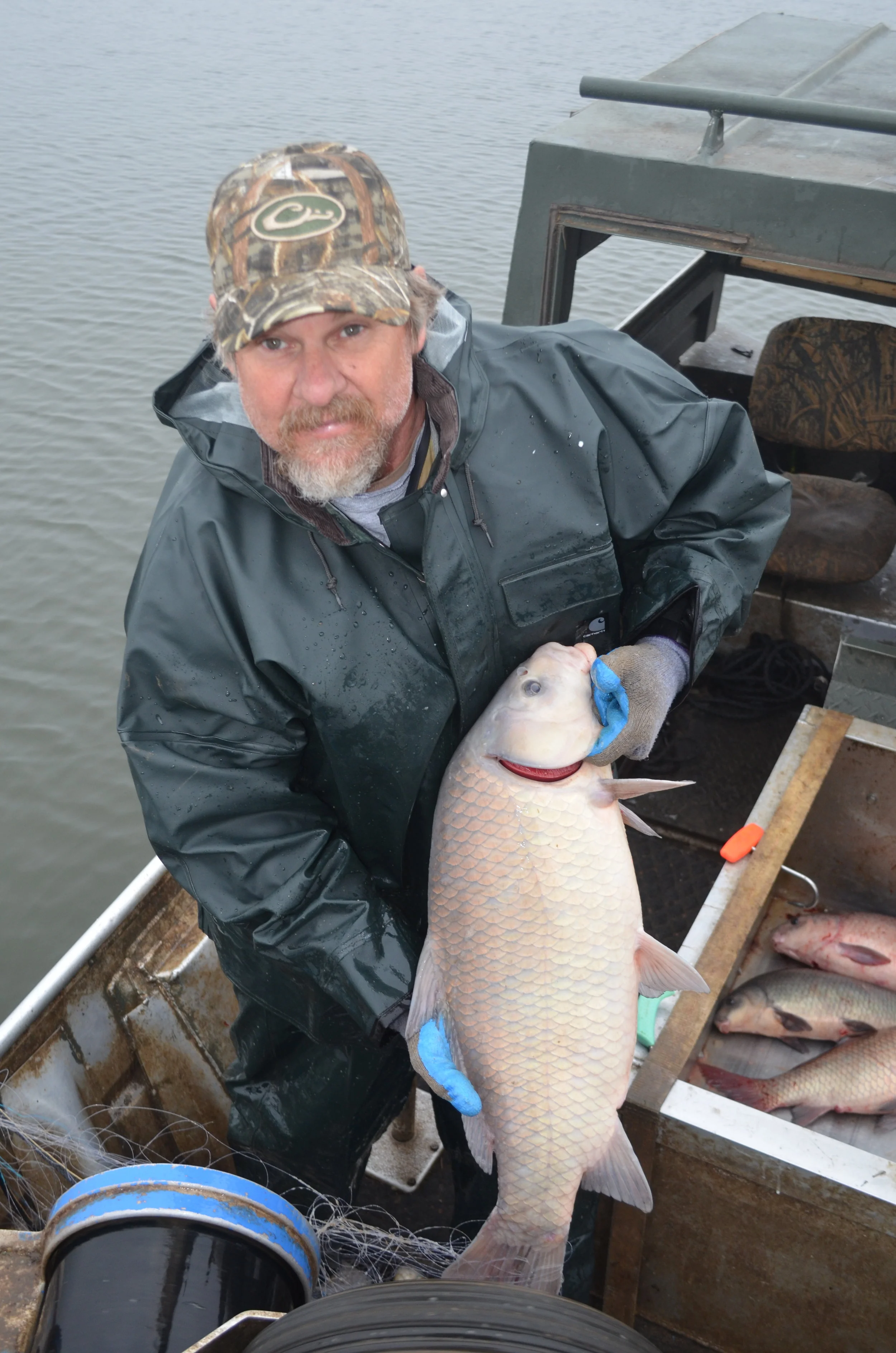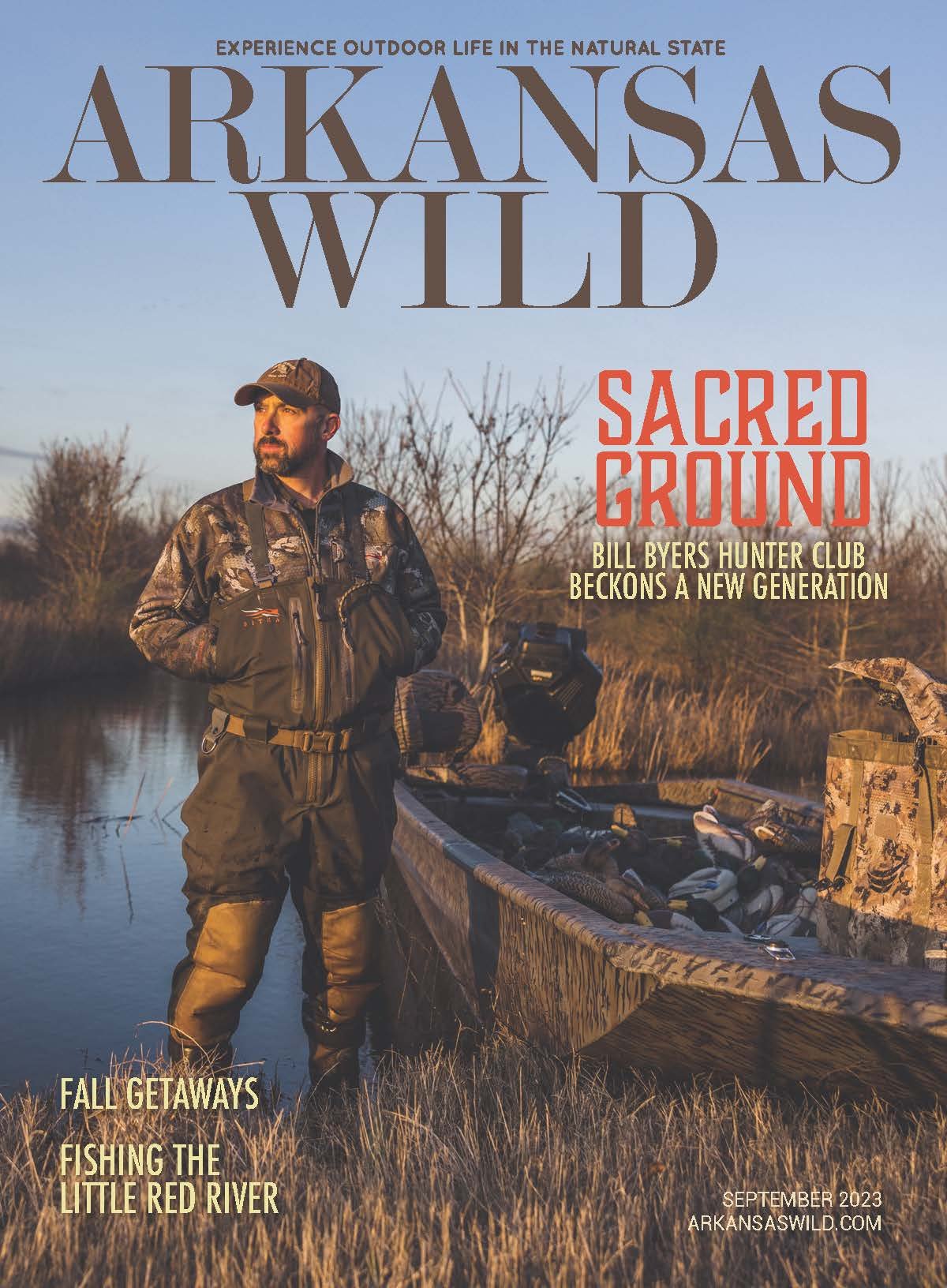The Realities of Rough Fish
FishermEn share how they put to good use fish that might otherwise be discarded
By Richard Ledbetter
Photo BY Richard Ledbetter/Ricky Dougan
Commercial fisherman Ricky Dougan of Scott hauls in a
large buffalo fish from the Arkansas River.
Catching Rough Fish
When one thinks of good eating fish, catfish, bass, brim and crappie typically come to mind. But that’s not to say there aren’t other freshwater species that are sometimes caught and served among a more elite group of Arkansas diners. Drum, carp, suckers, gar, grinnell, paddlefish and buffalo are referred to as “rough fish” by wildlife agencies to describe the less desirable sport-fishing species. They’re what many anglers throw back as unfit. But with a little extra care, even the roughest fish may be made palatable. In fact, as an acquired taste, some folks prefer them over more traditional aquatic fare.
We sought out Southeast-Arkansas natives with rough fish experience to learn about the upside of the less-popular species. James Golden from near Kingsland has fished the Saline River pert nearly all his life. He notes that while folks think bass is a good fighting fish, they’ve never gotten ahold of the right grinnell. He says they put up quite a fight. “We use a stiff cane pole and fly line. Leave a shrimp lying on the boat seat until it’s good and smelly and put that on a heavy hook. Grinnell will tear it up. You have to jerk real strong to set the hook because their mouth is so hard. But then the fight is on,” he explains. Though it can be eaten by humans, Golden says as far as eating, he mainly uses grinnell to fatten his hogs. Believe it or not, in certain northeastern and Asian markets, grinnell and paddlefish eggs are popular caviar. In fact, paddlefish caviar can even be found in Marvell, Arkansas at George’s Market. The price depends on the season and availability, but it can go for as much as $100 per pound.
Those aren’t the only rough fish Golden is experienced in catching. Golden also said he’s caught multiple buffalo on Atkins Lake with only a jig pole, ten-pound test line and six-pound hook, adding, “I never thought I’d land him, but we managed to get it in the boat with a dip net. When we put him in the live well he was so big we like to never got him out.” Golden offers a little advice for preparing buffalo: first, gut the fish and cut around the head to fleece the skin off each side around the fins. Score him across the belly into steaks and, he says, “there’s a lot of good meat from head to tail.” Be careful, though, because there’s a mess of bones in the top side.
T.C. Ashcraft of Warren has been fishing Pendleton on the Arkansas River for forty-seven years. He told us a hoop or tie down net used most any time of year on the Arkansas will result in catching all the fish you want. He catches a lot of gar in those nets and the occasional paddle-bill. He says, “Paddle-bill catfish are all cartilage with no bones. You score around the tail and twist it to pull out the whole spinal cord at once. If you rupture that cord, you’ve ruined the entire fish.” He warns chefs to expect to throw away a certain amount of meat to get to the good part, adding, “You slice off the outer layer of dark meat and toss that away. The white meat underneath is what you’re after. Cut that crossways into steaks, meal and fry it and it’s not bad. It has a texture similar to chicken.”
Ricky Dougan’s oven baked Asian carp accompanied by rice and Cajun gumbo. So fit to eat you’d never know it was rough fish.
Preparing Rough Fish
Past Arkansas Game and Fish Commission (AGFC) director Mike Knoedl said,, “If you carve out the tenderloin along either side of a gar’s back bone and slice out nuggets, it wads up into balls. Fry that and eat them while they’re hot and that’s pretty good. But you better eat it as soon as it comes out of the grease or you may not eat it at all.”
Ricky Dougan of Scott has been commercial fishing since 1988. Despite the regional popularity of catfish, he says he sells more buffalo fish these days, adding, “I’m not so sure there is that much greater demand, it’s just there are a lot fewer fishermen and you can’t buy buffalo ribs just anywhere anymore. There are probably two-thirds fewer commercial fishers than thirty years ago because of old-timers dying off and not as many young people taking up the hard trade.”
COOKING WITH ROUGH FISH
Sharing a few of his favorite rough fish recipes, Dougan said, “Gaspergou (drum) can imitate crab if you skin and fillet it like a bass. Pressure-cook the loin with some crab boil to tenderize it. Mash that up with onions, celery and crackers to form paddies. Corn meal and brown both sides in a cast-iron skillet and it tastes just like crab cakes.”
Switching species, he continues with the best way to prepare Asian carp. Take a 20- to 30-pound Asian carp, skin it out and cut off all the fat red meat on the outside. “Sear that white fillet on both sides in olive oil with a cast-iron skillet. Shove skillet and all in the oven on high heat for about fifteen minutes. There are a lot of little bones in carp but ‘the fleas come with the dog,’ as they say. When you take it out of the oven, rake a fork through the white flaky meat and those bones pull right out. Squeeze some lemon into a garlic and butter sauce to dip that tender tasty meat in and you’ve got some good eating.”
“As far as gar,” Dougan said, “needle-nose are preferable to alligator-gar, ’cause they’re more tender. Boil and grind it real fine and mix the meat with onions, celery and crackers to make cakes you drop in hot grease to deep fry. Slap that between a couple slices of bread and some people like it a lot.”
Wearing a telltale grin, Dougan asked, “Do you know how to fix German carp? Scale and gut it, leaving the skin and head on. Stuff that with garlic and lemon and put it on a cedar board in the oven at 350 degrees for half an hour. When you pull it out, throw away the carp and eat the cedar plank because there’s nothing you can do to make German carp edible!”
For more rough fish recipes read, “The Treasures of White Trash Cooking” by Ernest and Trisha Mickler.




